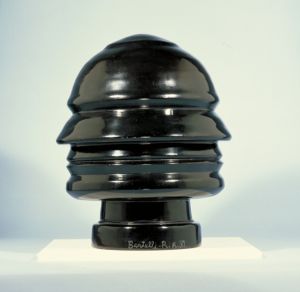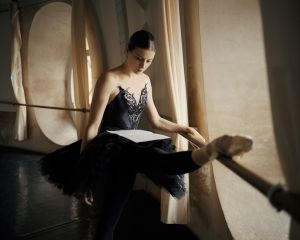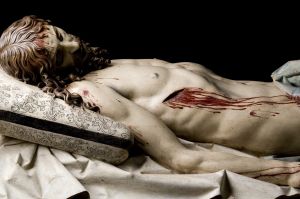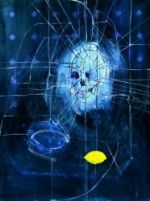Art 2009: Best and Worst | reviews, news & interviews
Art 2009: Best and Worst
Art 2009: Best and Worst
Picasso, Wallinger, Richter, Calle and Sacred Spanish art win - Hirst's the turkey
Picasso: Challenging the Past, National Gallery, London (February-June)
Originally shown in Paris, where Picasso’s paintings featured alongside works that had directly inspired them, this became a much tighter, more focused exhibition by the time it arrived in London. It was all the better for it. Hung thematically rather than chronologically, every period of Picasso’s oeuvre was covered. What was particularly exciting was that the curators had gathered together much that was unfamiliar: from the Goya-inspired periwigged self-portrait, painted when the artist was just 16, to the bold reclining nudes of this ever-inventive modern master’s final years.
 The Russian Linesman: Mark Wallinger, Hayward Gallery, London (February-May)
The Russian Linesman: Mark Wallinger, Hayward Gallery, London (February-May)
Mark Wallinger curated this wonderful cabinet of curiosities which provided a thrilling insight into the web of conceptual connections that preoccupy this Turner Prize-winning artist. It was all about blurring boundaries, political, geographical, the physical and conceptual, and those between art, science and life. It was intellectually intricate and rigorous but in a delightful and light-footed way. Robert Hooke’s painstakingly detailed drawing of a magnified flea could be found next to George Stubbs’s anatomical drawing of a crouching human skeleton, and Renato Giuseppe Bertelli’s dizzying Continuous Profile of Mussolini (pictured right) to Amie Siegel’s recent two-screen Berlin Remake, showing old footage of the city juxtaposing the artist’s modern-day replications. Perceptually challenging, each work made you do a double-take.
Gerhard Richter: Portraits, National Portrait Gallery, February-May
Gerhard Richter is one of the most technically assured and conceptually challenging artists among living painters, and his photorealist canvases manage to astonish, seduce and unsettle all at once. The NPG’s winning exhibition focused solely on a selection of the German artist’s portraits, from his blurry black and white "newsprint" images, to his iconic portraits of a grieving Jackie Kennedy and Betty, a portrait of his daughter with her head turned away. All the images are derived from photographs and the artist continually poses the question, “What can a portrait, any portrait, reveal if it can only reveal surface?” On so many beguiling levels, Richter’s portraits are deeply evocative.  Sophie Calle: Take Care of Yourself, Whitechapel Gallery, London (October-3 January)
Sophie Calle: Take Care of Yourself, Whitechapel Gallery, London (October-3 January)
These riveting confessions of a conceptual French artist opened at the recently extended and refurbished Whitechapel Gallery. Sophie Calle is an artist who suffers for her art but always has a clever palliative up her sleeve - she turns her lovelorn suffering into projects that are incisive, compelling, witty and moving. For Take Care of Yourself she asked 107 women to deconstruct a letter from a lover dumping her, and they did so in terms of their professions. Those of the fiction writer, the psychoanalyst, and the lexicographer were among the most engaging, by turns amusing, pitiless, comic and provocative (pictured left, Etoile dancer at the Opéra de Paris, Marie-Agnès Gillot, 2007). The exhibition also featured a survey of earlier work, including a film of Calle’s mother recording her dying moments, accompanied by a quietly devastating, beautifully written memorial poem, penned by Calle.
 The Sacred Made Real, The National Gallery, London (October-24 January 2010)
The Sacred Made Real, The National Gallery, London (October-24 January 2010)
The shockingly emaciated, gashed and bloodied body of Christ, just moments before death, forms the centrepiece of this powerful exhibition of polychromatic sculpture from 17th-century Spain. The name of the artist who carved it, Gregoria Fernández, is hardly known, even in Spain, yet he, together with the artists who painted these figures with such naturalistic flair, were influential to contemporary painters like Velázquez and Zurbarán. Both these latter artists, who also feature in this haunting exhibition, sought to capture the tangibility of the polychrome carving through their intricate modelling in paint. An exhibition, which, if you have any feeling, will make the hairs on the back of your neck stand on end.
Worst
 And now for my nominations for lame duck of the year. The first is perhaps an easy target but it would be too obvious an act to overlook. It’s Damien Hirst: No Love Lost, the Blue Paintings, Wallace Collection, (October till 24 January 2010). Hirst’s riffs on Francis Bacon once bristled with humour and pathos - his glass vitrine triptych of a trio of stuffed sheep brilliantly playing the part of George Dyer springs naturally to mind. But his Wallace Collection exhibition, a vanity project if ever there was one, since he paid to install it himself, was Bacon-lite as conceived by a technically unaccomplished 6th-former. Oh, and those wonky memento mori skulls, those solitary lemons and agitated perspective grids, he did it all himself - no assistants to paint by numbers this time, and it shows.
And now for my nominations for lame duck of the year. The first is perhaps an easy target but it would be too obvious an act to overlook. It’s Damien Hirst: No Love Lost, the Blue Paintings, Wallace Collection, (October till 24 January 2010). Hirst’s riffs on Francis Bacon once bristled with humour and pathos - his glass vitrine triptych of a trio of stuffed sheep brilliantly playing the part of George Dyer springs naturally to mind. But his Wallace Collection exhibition, a vanity project if ever there was one, since he paid to install it himself, was Bacon-lite as conceived by a technically unaccomplished 6th-former. Oh, and those wonky memento mori skulls, those solitary lemons and agitated perspective grids, he did it all himself - no assistants to paint by numbers this time, and it shows.
My second nomination is for a lesser-known artist, and it is, regrettably his first solo UK show: Pawel Althamer: Common Task, Modern Art Oxford (till 7 March 2010). Althamer is a young Polish artist who wants to weave a bit of science fiction into his community art projects. Here we see lots of men in shiny gold space suits sitting and walking about aimlessly in the otherwise almost empty gallery. Let’s hope the age of amateurish, 70s-style audience participation art will not be revived any time soon.
What to see in the New Year
The Sacred Made Real at the National Gallery runs until 24 January, and shows religious art of the Spanish Golden Age. The polychrome sculptures are made startlingly real indeed: a bloodied and emaciated Christ shown at the point of death; the anatomically correct decapitated head of Saint John the Baptist; an eerily lit Saint Francis Standing in Ecstasy. Plus wonderful paintings by Velázquez and Zurbarán.
more Visual arts
 Eye to Eye: Homage to Ernst Scheidegger, MASI Lugano review - era-defining artist portraits
One of Switzerland's greatest photographers celebrated with a major retrospective
Eye to Eye: Homage to Ernst Scheidegger, MASI Lugano review - era-defining artist portraits
One of Switzerland's greatest photographers celebrated with a major retrospective
 Stephen review - a breathtakingly good first feature by a multi-media artist
Melanie Manchot's debut is strikingly intelligent and compelling
Stephen review - a breathtakingly good first feature by a multi-media artist
Melanie Manchot's debut is strikingly intelligent and compelling
 Fantastic Machine review - photography's story from one camera to 45 billion
Love it or hate it, the photographic image has ensnared us all
Fantastic Machine review - photography's story from one camera to 45 billion
Love it or hate it, the photographic image has ensnared us all
 Yinka Shonibare: Suspended States, Serpentine Gallery review - pure delight
Weighty subject matter treated with the lightest of touch
Yinka Shonibare: Suspended States, Serpentine Gallery review - pure delight
Weighty subject matter treated with the lightest of touch
 Jane Harris: Ellipse, Frac Nouvelle-Aquitaine MÉCA, Bordeaux review - ovals to the fore
Persistence and conviction in the works of the late English painter
Jane Harris: Ellipse, Frac Nouvelle-Aquitaine MÉCA, Bordeaux review - ovals to the fore
Persistence and conviction in the works of the late English painter
 Sargent and Fashion, Tate Britain review - portraiture as a performance
London’s elite posing dressed up to the nines
Sargent and Fashion, Tate Britain review - portraiture as a performance
London’s elite posing dressed up to the nines
 Zineb Sedira: Dreams Have No Titles, Whitechapel Gallery review - a disorientating mix of fact and fiction
An exhibition that begs the question 'What and where is home?'
Zineb Sedira: Dreams Have No Titles, Whitechapel Gallery review - a disorientating mix of fact and fiction
An exhibition that begs the question 'What and where is home?'
 Yoko Ono: Music of the Mind, Tate Modern review - a fitting celebration of the early years
Acknowledgement as a major avant garde artist comes at 90
Yoko Ono: Music of the Mind, Tate Modern review - a fitting celebration of the early years
Acknowledgement as a major avant garde artist comes at 90
 Unravel: The Power and Politics of Textiles in Art, Barbican review - the fabric of dissent
An ambitious exploration of a neglected medium
Unravel: The Power and Politics of Textiles in Art, Barbican review - the fabric of dissent
An ambitious exploration of a neglected medium
 When Forms Come Alive, Hayward Gallery review - how to reduce good art to family fun
Seriously good sculptures presented as little more than playthings or jokes
When Forms Come Alive, Hayward Gallery review - how to reduce good art to family fun
Seriously good sculptures presented as little more than playthings or jokes
 Entangled Pasts 1768-now, Royal Academy review - an institution exploring its racist past
After a long, slow journey from invisibility to agency, black people finally get a look in
Entangled Pasts 1768-now, Royal Academy review - an institution exploring its racist past
After a long, slow journey from invisibility to agency, black people finally get a look in
 Barbara Kruger, Serpentine Gallery review - clever, funny and chilling installations
Exploring the lies, deceptions and hyperbole used to cajole, bully and manipulate us
Barbara Kruger, Serpentine Gallery review - clever, funny and chilling installations
Exploring the lies, deceptions and hyperbole used to cajole, bully and manipulate us

Add comment